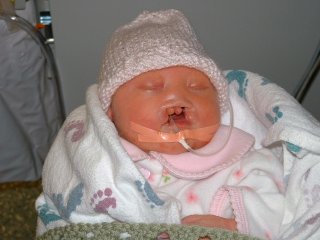It took me about 1 1/2 weeks to be able to correctly say the word - Ho-Lo-Pros-En-Ce-Pha-Ly
Just a big word for such a little girl.
Below is from the
Carter Centers WebsiteWhat is Holoprosencephaly?
Holoprosencephaly (HPE) is a birth defect that occurs during the first few weeks of intrauterine life. HPE is a disorder in which the fetal brain does not grow forward and divide as it is supposed to during early pregnancy (incomplete cleavage of the embryonic forebrain/failure of the prosencephalon to cleave into the cerebral and lateral hemispheres).
This brain malformation can range from mild to severe and is classified into four types:
(1) Alobar (severe)--where the brain is not divided and there are severe abnormalities (there is an absence of the interhemispheric fissure, a single primitive ventricle, fused thalami, and absent third ventricle, olfactory bulbs and tracts and optic tracts).
(2) Semi-Lobar (moderate)--where the brain is partially divided and there are some moderate abnormalities; where there are two hemispheres in the rear but not the front of the brain (there are partially separated cerebral hemispheres and a single ventricular cavity).
(3) Lobar (mild)--where the brain is divided and there are some mild abnormalities (there is a well developed interhemispheric fissure however there is some fusion of structures).
(4) Middle Interhemispheric Variant (MIHV) -- where the middle of the brain (posterior frontal and parietal lobes) are not well separated.
Children diagnosed with HPE may have a small head (microcephaly), excessive fluid in the brain (hydrocephalus), variable degrees of mental retardation, epilepsy, endocrine abnormalities, or abnormalities of other organ systems such as cardiac, skeletal, genitourinary, and gastrointestinal. Mildly affected children may exhibit few symptoms and may live a normal life.
Facial deformities are often present in many children diagnosed with HPE. Mild forms of facial abnormalities may include a flat single-nostril nose (cebocephaly), close set eyes (hypotelorism), cleft lip and/or palate, or just one upper middle tooth (single maxillary central incisor). More severe facial deformities may include a single central eye (cyclopia), a nose located on the forehead (proboscis), or missing facial features.
What causes holoprosencephaly?
The cause of HPE is currently unknown. Often, no specific cause can be identified. Suggested risk factors include maternal diabetes, infections during pregnancy (syphilis, toxoplasmosis, rubella, herpes, cytomegalovirus), and various drugs taken during pregnancy (alcohol, aspirin, lithium, thorazine, anticonvulsants, hormones, retinoic acid). Women with previous pregnancy loss and first trimester bleeding are also more likely to have a child diagnosed with HPE.
Although many children with HPE have normal chromosomes, specific chromosomal abnormalities have been identified in some patients. There is evidence that in some families, HPE is inherited (autosomal dominant as well as autosomal or X-linked recessive inheritance).
Several
genes have been identified that play a role in holoprosencephaly.
How common is this defect?
It is estimated that HPE affects between 1 in 5,000-10,000 live births. Since many pregnancies with a fetus diagnosed with HPE end in miscarriage, the frequency of HPE among all pregnancies may be as high as 1 in 200-250. Current studies indicate that only 3% of all fetuses with HPE survive to delivery and the vast majority of these infants do not survive past the first six months of life. The prognosis for a child diagnosed with HPE depends on the type of HPE and the presence of associated anomalies. The most severely affected children may live several months or years and the least affected may live a normal life span. Almost two-thirds of affected patients have alobar HPE and approximately one quarter are diagnosed with semilobar HPE.
Summary
HPE is characterized by a failure of transformation of the prosencephalon into cerebral hemispheres with separate lateral ventricles. HPE has many associated anomalies, both of the nervous system and face. HPE is also associated with malformations in other body systems, particularly when it has a chromosomal etiology. The true spectrum of HPE, its clinical manifestations, and underlying etiologies require further elucidation. Applying this knowledge to individuals and their families is of utmost importance.
Trinity has Semi-Lobar Holoprosencephaly - the moderate form.
I hope in the future to be able to receive the genetic testing to see if Trinity's genes did mutate themselves, if Tony and I passed this down, or is it was an environmental factor. The test alone to see if Trinity did it herself is $1,800 dollars. We might be able to get this testing done with just the cost of having the blood drawn. That would be great.




